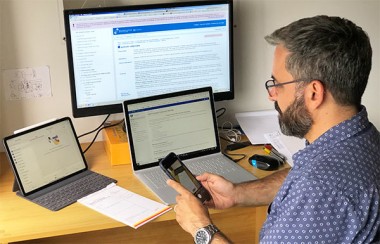New e-prescription guidelines lead to telehealth success during COVID-19 lockdown

Reference: Teleheath Prescribing Update - April 2020
The COVID-19 pandemic has generated a shift towards telehealth as being part of the solution for breaking community transmission. In addition, key changes have been made regarding electronic prescribing of drugs which has a significant impact on clinicians – particularly those in the field of mental health.
Legacy guidelines from the Medical Council create telehealth barrier
Until recently, the Medical Council of New Zealand’s guidelines had stated that mental health practitioners could only prescribe psychotropic drugs via telehealth following an initial in-person consultation. In remote regions of New Zealand where the population is sparse, driving times can become a severe barrier to consultations taking place. The inability to set up a remote consultation and prescribe a drug electronically for the patient to pick up in their hometown can have a severe impact on the health of rural New Zealanders.
“New Zealand is one of the countries which has a very high suicide rate – particularly in the 16-24-year age group. It can also be a big issue in remote areas where farmers live and where guns are more readily available. If someone needs to drive two hours to have a session with me - at the end of which they could get Prozac - they will not come,” says Dr Yariv Doron, Child & Adolescent Psychiatrist, Taranaki DHB.
In conjunction with the Telehealth Leadership Group, led by Dr Ruth Large, Dr Doron has in the past lobbied the Medical Council of New Zealand (MCNZ) to consider revising this guideline in order to improve the access to healthcare for rural New Zealanders and to ease the burden on mental health clinicians. “In my case, my colleague retired, we were unable to recruit to fill that position and suddenly my caseload was huge as I was responsible for the region of Taranaki. If I have to drive 1.5 hours each way to see a new client, I simply wouldn’t be able to keep up,” says Dr Doron.
MCNZ updates telehealth guidelines, Ministry releases waiver
A small silver lining has emerged, however, as part of the changes made in response to COVID-19. The MCNZ has updated their telehealth guidelines to allow for assessments of mental health patients to be made remotely and the Ministry of Health has released a waiver to allow for prescriptions to be shared electronically during the lockdown “As part of lockdown, myself and my teammates at the DHB have all had to transition to telehealth in order to provide support for our clients,” says Dr Doron. “The changes introduced recently by the Medical Council and the Ministry of Health in response to COVID-19 have made a significant difference in terms of streamlining the prescription process and also allowing clinicians to maintain social distancing while treating patients.”
Wider adoption of telehealth embraced

Dr Doron and his colleagues have found that the overwhelming response towards the telehealth sessions has been extremely positive – especially with the younger age group who are very comfortable with the use of video conferencing. “If we didn’t have telehealth capabilities at this time, it would have been either completely impossible to continue to support our clients or we would continue to have to see people in person - in which case community transmission would be much higher. The success we are having with telehealth has led a number of my colleagues towards a decision to continue with telehealth consultations for a number of their clients after the lockdown is lifted.”
New electronic system required for controlled drugs
The final piece in the puzzle for Dr Doron remains the issue around electronic prescriptions for controlled drugs. Given that some of these drugs are potentially addictive and can, without strict control measures in place, become powerful street drugs, any electronic prescription system must involve robust security systems. Such electronic systems do exist, however, where the prescription is generated with a barcode which maintains both the integrity of the prescription and the identity of the clinician.
“Some of the DHBs are not quite there yet in New Zealand and so during lockdown, I will still need to leave my house to go to the office to fax a prescription for a controlled drug through to the pharmacy. I will also need to hand an envelope with the hard copy to our DHB postal service. Through this whole process, I am adding in layers of potential community transmission which isn’t ideal – I would prefer to minimise physical contact as much as possible,” says Dr Doron. “I can see that the Medical Council needs to balance the needs of the time against the security required around these drugs. But, I am hopeful that the learnings we gain through the lockdown period may lead us further towards leveraging more of what telehealth can offer.”
Read more on prescribing rules: www.telehealth.org.nz/prescribing
